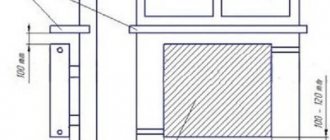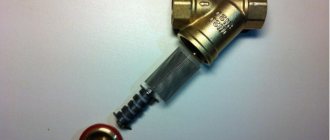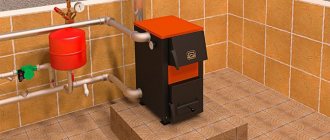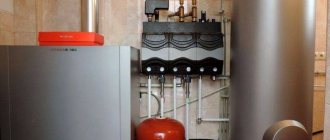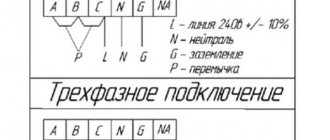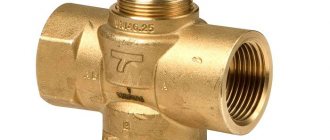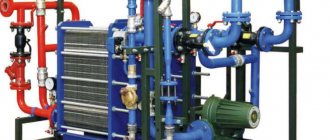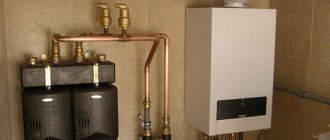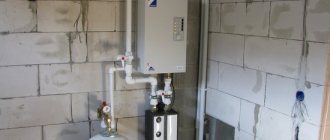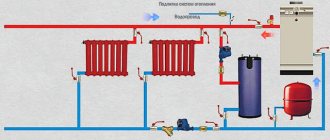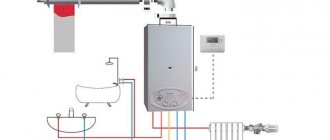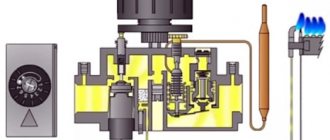External inspection of the heating system
Unfortunately, they make a heating system for the house so that you can live comfortably in the house. The heating of an apartment building “for show” can be determined by a simple inspection. Poor quality heating work can be identified by the following signs:
- Small heating radiators that do not match the size of the windows;
- Panel convectors are installed without a protective casing;
- Radiators are installed crookedly;
- The plastic heating pipeline is embedded in the screed. It is unacceptable.
Cold and hot water supply
After installing electricity, the walls are sewn up or plastered and the next stage of house construction begins - installation of sewerage, then cold and hot water supply. It is very comfortable. The walls are smooth and you can clearly mark everything and not chisel more than required. And sometimes we install water sockets to connect plumbing fixtures. Then the plasterer comes and adds 50 mm. The water outlets are sinking. And in order to connect plumbing fixtures later, you have to use extension cords. It’s even worse when the water sockets stick out from the tiles. Then there is a risk that the decorative cup will not fit flush against the wall.
Finding out the heating scheme of the house (apartment)
There are two fundamentally different heating schemes: collector and pipe. Both are easy to identify by visual inspection.
With a manifold heating scheme, a separate pipeline connects to all radiators in the apartment. All heating pipes are brought together into a common distribution unit called a manifold. In large apartments there may be more than one such collector.
This is a very successful heating scheme and if it is done correctly, it adjusts and works perfectly. However, completely redoing such a heating scheme will be much more expensive.
The pipe circuit can be two-pipe or one-pipe. In new apartment buildings, a two-pipe heating system is used. With this scheme, heating radiators are divided into groups, each group has its own heating risers. The risers are clearly visible in the corners of the rooms.
This heating system is dependent, that is, in the absence of bypasses (jumpers) on the radiators, a heating failure in your neighbor will lead to a heating failure in yours. In addition, the quality and cleanliness of each of your radiators will affect the performance of the radiators of its group. Repairing or replacing such a heating system is easier and cheaper. Installing bypasses and high-quality radiators solves all heating problems in a new building.
Electric heating: heated floors and separate heating devices
One of the main topics of conversation when choosing heating is electric floors. There are quite a lot of discussions on the Internet. Unfortunately, not all of them are based on the actual use of film, cable system or ready-made mats. In most cases, aggression manifests itself at an amateurish level with a lot of skepticism.
First of all, it is worth stating that electric heated floors have several main subtypes, which determine the possibility of use in premises for various purposes. It should also be supplemented with a statement about the cost, which cannot be as low as imaginary experts say, and if it is, then such a warm floor will clearly not be the most effective solution. There are many examples of using frankly cheap Korean IR film that really works. But the wrong choice of its power and installation methods for the sake of economy is a direct path to the floor temperature, which is equal to the air temperature in the room. What kind of heating are we talking about? Therefore, an unspoken division appeared - warm floors for directly heated floors, and warm floors for heating premises!
You need to carefully study the topic, compare proposals and characteristics:
- Warm floors under tiles - thin ready-made underfloor heating mats with a heating electric cable or separate installation of the cable in the screed;
- Warm electric flooring under laminate, parquet, carpeting - infrared films!
The purpose of the premises, the type of screed, thermal insulation of the floor and walls, the type and characteristics of the decorative finish, as well as the power of the heated floor must be taken into account. If the assessment on the last parameter is not considered by the buyer, and he purchases an inexpensive film with a power of 120 W/m2 for a corridor or hall, basement or balcony, the heating will be corresponding... the result is a barely warm floor, and minimal or complete heating of the room. Especially if you additionally fill the film with screed and lay porcelain stoneware or tiles on its surface. This is literally walled up money!
A properly selected heated floor, and only with high-quality thermal insulation of the room, when heat loss is significantly reduced, can become the main source of heat. Or you will have to select maximum power values that will work for the sake of heat, but definitely not economy!
Regardless of thoughts and available facts, electric heated floors are used for heating apartments in new buildings in which it is impossible or there is no desire to connect water heating.
Advantages of electric heated floors:
- Wide range of purposes, application in almost any room;
- Availability of installation solutions for any type of decorative finish;
- Invisible heating system that is completely integrated into the floor;
- Main heating, auxiliary or nominal underfloor heating for comfort of movement;
- The minimum thickness of the system, which does not require reducing the height of the room;
- A wide range of components and accessories to allow you to choose based on quality, cost, ease of use and other parameters;
- Precise temperature control, installation of temperature sensors and thermostats can significantly increase the level of control and reduce energy consumption;
- Uniform heating of the surface;
- Elimination of additional expensive equipment for connecting the system;
- High level of security with several levels of control;
- Quick installation with minimal requirements, installation and connection even with your own hands, according to the instructions!
There are also disadvantages that may affect your choice:
- The choice of a quality system comes with serious financial costs;
- High cost of operating the heating system. Unskilled installation can reduce the temperature, and therefore lead to the need to increase power to achieve the desired result. This will reduce the potential cost savings benefits to zero;
- Necessity of precise calculation to determine the connection possibilities taking into account the input!
If we talk about this system in detail, each of the above lists can be doubled. But all the advantages and disadvantages are considered not only nominally, but also taking into account a comparison of heating systems and the individual characteristics of the premises. Therefore, at this stage, a more serious immersion in the topic is irrational!
An indisputable fact remains that a warm floor can be an independent heating system for an apartment in a new building. But more often, a cable system or infrared heating film is used as additional heating to improve the comfort of the interior!
New open plan developments
In apartments with free modern layouts, apartment heating schemes are designed in a horizontal plane using a collector heating scheme.
The developer installs heating risers in specially made shafts. Heating in an open-plan apartment is designed and done individually. As a rule, such heating systems are closed with a screed.
It is important to pay attention to:
- Calculation of the heating system, in particular the diameter of the underwater pipes to the radiators from the collector,
- Selection and calculation of the reservoir,
- Selection of radiators
- The main thing is to choose heating pipes certified for covering with screed. These pipes are not in short supply; they are called cross-linked polyethylene heating pipes.
Similar materials on the company website
E-35-1.4-350GM - Steam boiler Technical characteristics of E-35-1.4-350GM Type: Steam boiler Fuel: gas, liquid fuel Rated...
Direct acting pressure regulator
There is a variety of such devices on the modern market. They all differ in design…
Heat pumps De Dietrich KALIKO LLC DESIGN PRESTIGE Heating water supply boiler room 8(495)744-67-74 Heating repair Water supply repair…
Gas equipment
It is quite difficult to install gas equipment for decentralized heating systems, since the installation requires a previously prepared technical design, approvals and high competence of specialists.
Connecting one apartment involves installing a gas boiler, in which a specialist seals the equipment and records this in the logbook. Installation of gas devices requires a powerful ventilation system. It is this factor that in most cases is the reason for refusals to issue permits. This problem can be solved by using a separate chimney, which is vented outside with the installation of a filter. A conventional ventilation system will not work in this case; an additional supply valve must be added to it.
For the apartment, wall units with two circuits are used - they provide sufficient power to heat a small room and at the same time serve as a boiler for heating water. The gas boiler is equipped with an open or closed combustion chamber and does not require additional installation of a gas duct. The fan performs the function of supplying and extracting air from the street, and combustion products are eliminated through special pipes. The device does not require a separate room and can be installed in the kitchen, since this is the most ventilated room.
The economical use of heat resources within the next few years of operation allows you to recoup the cost of the boiler. A multi-stage safety system protects the equipment from overheating in the event of a water pump failure, and the burner automatically turns off. External temperature sensors, using external control, maintain the optimal heat level and stabilize the intensity of water heating.
Features of boiler installation
Each type of gas boiler has its own installation algorithm, however, during installation there are 2 general conditions: the dimensions of the room and its purpose.
The height of the room in which the boiler is installed must be at least 2.5 m, and the area must be at least 15 m3. The presence of ventilation and exhaust hood are mandatory requirements.
It is prohibited to install gas equipment in the bathroom, toilet and living rooms.
The system is pre-pressured to P = 1.8 atm, and then deaerated. After this, all connection elements are checked for leaks.
Installation of a voltage stabilizer is mandatory and installation of an uninterruptible power supply is highly desirable. This is necessary for stable operation of electronic control elements.
The first start-up precedes the filling of the system with water. To do this, the device must be turned off. To avoid the formation of air bubbles, the heating system should be filled with water gradually.
Installation of any gas equipment must be carried out at temperatures from +5 to +35 degrees. Such work is not carried out in cold weather.
Where does the heat come from?
The powerful CHPP-12, one of 16 power plants, is impossible not to notice if you walk along Berezhkovskaya embankment. Behind the gates, where you can only get by with passes, everything is no less large - the most convenient way to move around the vast territory is by car. Turbines, generators, boilers, pipelines and various other equipment fill the multi-level spaces of the workshops - it is thanks to their work that Muscovites’ apartments are warm in the fall, winter and spring.
In the machine room of the combined cycle gas power unit PGU-220 there are steam and gas turbines, a waste heat boiler and much more. Moscow thermal power plants operate in the mode of combined generation of electricity and heat. To produce thermal energy, steam from turbine extractions is used, supplied to network horizontal heaters. The water passing through them is heated and supplied under pressure to the city heating network through network pumps.
This power unit is fully automated, and everything that happens here can be found on the control panel. Information about the parameters and operating modes of the equipment is displayed on monitors located both on the wall and on the operators’ desks. If any problem arises, our specialists will fix it immediately. It is interesting that CHP plants can switch to the heating mode at any time, even in summer, if such a need arises: the equipment is always in a prepared state.
When the heating is turned on and off in Moscow
Heat began to be supplied to houses and social facilities in Moscow on September 28 due to numerous requests from residents. “Today, the supply of heat to educational and healthcare institutions has been completely completed, and the supply of heat to all residential buildings has almost been completed,” said Deputy Mayor of Moscow for Housing, Communal Services and Landscaping Pyotr Biryukov.
According to the capital’s heat supply scheme, MOEK PJSC ensures the delivery of coolant to the building boundary, and intra-house heat distribution is the responsibility of building owners and managers,” said Gasan Gasangadzhiev, head of the Department of Housing and Communal Services.
The modern power unit PGU-220 appeared at CHPP-12 in 2015. With its commissioning, the station’s electrical power increased by more than one and a half times.
